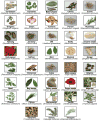Molecular targets of nutraceuticals derived from dietary spices: potential role in suppression of inflammation and tumorigenesis
- PMID: 19491364
- PMCID: PMC3141288
- DOI: 10.3181/0902-MR-78
Molecular targets of nutraceuticals derived from dietary spices: potential role in suppression of inflammation and tumorigenesis
Abstract
Despite the fact cancer is primarily a preventable disease, recent statistics indicate cancer will become the number one killer worldwide in 2010. Since certain cancers are more prevalent in the people of some countries than others, suggests the role of lifestyle. For instance cancer incidence among people from the Indian subcontinent, where most spices are consumed, is much lower than that in the Western World. Spices have been consumed for centuries for a variety of purposes-as flavoring agents, colorants, and preservatives. However, there is increasing evidence for the importance of plant-based foods in regular diet to lowering the risk of most chronic diseases, so spices are now emerging as more than just flavor aids, but as agents that can not only prevent but may even treat disease. In this article, we discuss the role of 41 common dietary spices with over 182 spice-derived nutraceuticals for their effects against different stages of tumorigenesis. Besides suppressing inflammatory pathways, spice-derived nutraceuticals can suppress survival, proliferation, invasion, and angiogenesis of tumor cells. We discuss how spice-derived nutraceuticals mediate such diverse effects and what their molecular targets are. Overall our review suggests "adding spice to your life" may serve as a healthy and delicious way to ward off cancer and other chronic diseases.
Figures






References
-
- Brower V. Nutraceuticals: poised for a healthy slice of the healthcare market? Nat Biotechnol. 1998;16:728–731. - PubMed
-
- Zeisel SH. Regulation of “nutraceuticals”. Science (New York, NY) 1999;285:1853–1855. - PubMed
-
- Miyajima Y, Kikuzaki H, Hisamoto M, Nikatani N. Antioxidative polyphenols from berries of Pimenta dioica. BioFactors (Oxford, England) 2004;21:301–303. - PubMed
Publication types
MeSH terms
Grants and funding
LinkOut - more resources
Full Text Sources
Other Literature Sources
Medical

